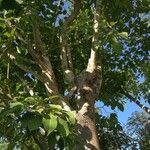Trees, evergreen, glabrous except stipules. Branchlets pale yellow when dry, strong, slightly curved. Stipules broadly ovate, ca. 1 cm, pubescent. Leaves clustered apically on branchlets; petiole 2-7 cm, glabrous; leaf blade ± elliptic to broadly ovate, 4.5-11 × 3-8 cm, adaxially glabrous and shiny when dry, base broadly cuneate to rounded, apex mucronate; secondary veins 5-12 on each side of midvein, raised on both surfaces. Figs axillary on short woody branchlets or on leafless older branchlets, in clusters of 2-4, red when mature, depressed globose, 5-7 mm in diam., with conspicuous interfloral bristles, tuberculate, sessile or subsessile; involucral bracts broadly ovate. Male, gall, and female flowers within same fig. Male flowers: few, near apical pore; calyx lobes connate; stamen 1; filament short; anther broadly ovoid. Gall and female flowers: calyx lobes 2 or 3, lanceolate; style in female flowers longer than in gall flowers. Fl. Apr-May, fr. Jun-Jul.
More
A fig. It is a large tree. The leaves are oval and entire. They are 5-11 cm long by 3-8 cm wide. They are leathery and taper to the tip. Male and female flowers are separate. The fruit receptacles hang in clusters from the stem. They are in groups of 2-4. The fruit are small and yellow when ripe.

